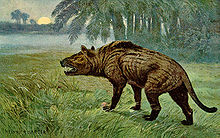Hyaenodon
| Hyaenodon Temporal range:
| |
|---|---|

| |
| H. horridus, Royal Ontario Museum. | |
| Scientific classification | |
| Kingdom: | |
| Phylum: | |
| Class: | |
| Order: | |
| Family: | |
| Genus: | Hyaenodon Leidy, 1869
|
| Species [1] | |
|
H. bavaricus | |
Hyaenodon ("hyaena-toothed") is an extinct genus of Hyaenodonts, a group of carnivorous creodonts of the family Hyaenodontidae endemic to all continents except South America, Australia and Antarctica, living from 42—15.9 mya, existing for approximately 26.1 million years.[2]
Morphology

Some species of this genus were amongst the largest terrestrial carnivorous mammals of their time; others were only of the size of a marten. Hyaenodon was one of the latest genera of the Hyaenodonts and is known from the Late Eocene to Early Miocene. Remains of many species are known from North America, Europe, Asia and Africa (In 1993 42 species were distinguished).[3]
Not typical of early carnivorous mammals, the Hyaenodon had a very massive skull but only a large brain. It had a long skull with a narrow snout - much larger in relation to the length of the skull than in canine carnivores, for instance. Its neck was shorter than its skull, while its body was long and robust and terminated in a long tail. Despite the name, these creatures are not related to hyenas.
The average weight of adult or subadult H. horridus, the largest North American species, is estimated to about 40 kilograms (88 lb) and may not have exceeded 60 kilograms (130 lb). H. gigas, the largest Hyaenodon species was much larger, being 500 kilograms (1,100 lb) and around 10 feet.[4] H. crucians from the early Oligocene of North America is estimated to only 10 to 25 kilograms (22 to 55 lb). H. microdon and H. mustelinus from the late Eocene of North America were even smaller and weighed probably about 5 kilograms (11 lb).[5]
Range and species

In North America the last Hyaenodon disappeared along with species like H. brevirostris in the late Oligocene. In Europe they had already vanished earlier in the Oligocene. From the Miocene in Africa there are three species (H. andrewsi, H. matthewi and H. pilgrimi) known, but none of these reached the dimensions of Asian species like H. gigas and H. weilini[3]
In popular culture
- A hyaenodon appeared in Walking with Beasts attacking an Indricotherium and a Chalicotherium.
- David Innes adopts a hyenadon as a personal pet, naming him Raja, in Pellucidar, the second book of Edgar Rice Burroughs' series set in the Earth's core.
- In The Land That Time Forgot, also by Burroughs, set on the fictional island of Caprona, Lys is found confronted by three hyaenodons, having apparently killed another.
- Hyaenodons arriving via a time anomaly terrorized Jenny Lewis' wedding in Episode 4.6 of Primeval.
- The television program Prehistoric Predators - Razor Jaws[6] depicted a Hyaenodon horridus killing a Dinictis "false sabertooth" nimravid in what is now North Dakota by multiple penetrating bites to the skull.[7]
See also
References
- ^ Mikko's Phylogeny Archive — Hyaenodonts
- ^ PaleoBiology Database: Hyaenodon, basic info
- ^ a b Wang, Xiaoming, Qiu, Zhanxiang, and Wang, Banyue, 2005. Hyaenodonts and Carnivorans from the Early Oligocene to Early Miocene of Xianshuihe Formation, Lanzhou Basin, Gansu Province, China, Palaeontologia Electronica Vol. 8, Issue 1; 6A: 14p, online Cite error: The named reference "Wang, 2005" was defined multiple times with different content (see the help page).
- ^ WANG X. & TEDFORD R. H. 2008. — Dogs, their fossil relatives and evolutionary history. Columbia University Press: 1-219.
- ^ Naoko Egi (2001) Body Mass Estimates in Extinct Mammals from Limb Bone Dimensions: the Case of North American Hyaenodontids _Palaeontology 44 (3) , 497–528 doi:10.1111/1475-4983.00189
- ^ https://www.dmr.nd.gov/ndgs/newsletter/nl2010/National%20Geographic.pdf Accessed January 13, 2012
- ^ Hoganson, John W; and Person, Jeff. "Tooth puncture marks on a 30 million year old Dinictis skull. Geo News. July 2011. p12-17" Accessed January 13, 2012 from: https://www.dmr.nd.gov/ndgs/.../Tooth%20puncture%20marks.pdf
- Haines, Tim & Chambers, Paul. (2006) The Complete Guide to Prehistoric Life. Canada: Firefly Books Ltd.
